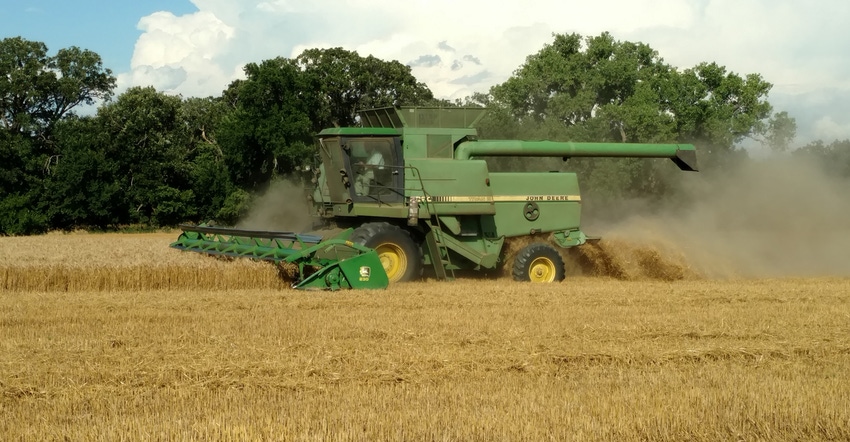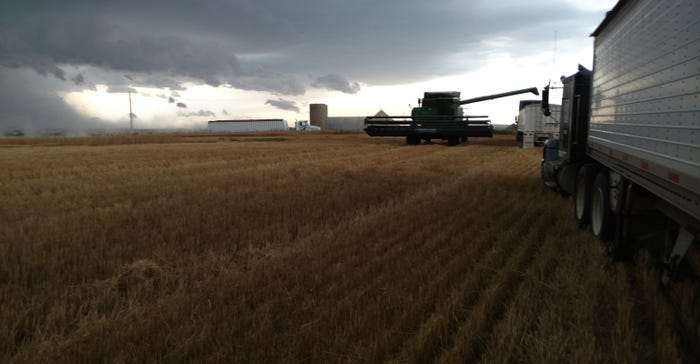
Lincoln County farmer John Thaemert became a believer in the Farm Strategy program, a new initiative to help wheat producers capture higher values through direct marketing, in the 2017 crop year when he sold much of his crop at a premium of more than $2 a bushel.
“It’s been a very positive experience for me. I really like the concept,” he says. “It won’t be an option for everybody, but it sure worked for me.”
Thaemert, who has had a dual career in banking and farming for several years and has held leadership positions in the Kansas and National Association of Wheat Growers, including president of NAWG in 2007 and 2008, says he has tried other programs but nothing has held the promise that he sees in Farm Strategy.
Andrew Hoelscher, founder of Farm Strategy, says his program is aimed at helping connect producers to end users and guide them in the direction of thinking of their crop as a food ingredient rather than as a commodity grain.
“Traditionally, everything in wheat has been set up on the commodity model — producing the most bushels possible and selling everything through a grain handling terminal or a cooperative elevator. The problem is, there is no incentive in that to produce a higher-quality wheat,” he said.
Read more about the Farm Strategy Model here.
Over the decades, that has taken a toll. Hard red winter wheat growers have produced more and more bushels, but fewer and fewer of them have the milling and baking characteristics that are the most important to millers and bakers.
“The end users of the industry haven’t been good at communicating what they need and offering producers an incentive to provide that,” he says. “Farm Strategy is designed to help farmers know what they have, who needs it and how to get paid to grow it again.”
Thaemert says he believes that millers and bakers haven’t fully realized that they could work with producers prior to planting time to encourage them to plant the varieties that have shown the most promise for them, and to recommend the agronomic practices that will improve things they want such as higher protein content and better flour strength.
 BEATING THE RAIN: Semis line up in the face of a thunderstorm to get as much wheat as possible out of field ahead of the rain. Farmer John Thaemert says they didn’t finish the field before the storm, but they did get the semis loaded and the combine empty before it hit.
BEATING THE RAIN: Semis line up in the face of a thunderstorm to get as much wheat as possible out of field ahead of the rain. Farmer John Thaemert says they didn’t finish the field before the storm, but they did get the semis loaded and the combine empty before it hit.

“The value of the grain in a loaf of bread is minimal compare to the sale price of the bread, but it is one of the most important things to consistent quality of the loaf,” he says. “That makes it practical for an end user to be able to offer a premium to get the quality of grain he knows will give him the flour and the dough that he needs.”
Thaemert says keys to the program are sampling every truckload of wheat at harvest so you can identify the high-quality traits of that load and the ability to segregate and store that grain so you can market it wisely. He said smaller bins, 7,000 to 10,000 bushels, offer the best assurance that the quality of the total bin will be similar.
“As a general rule, everything grown the same way in the same area will have similar quality,” he says. “If you get 40 or 50 miles away, then the weather pattern may have been different, the soil type is different or other factors are at play. That’s why you need to sample every load for testing.”
He added that different users are looking for different traits.
"Some bakers are looking for different characteristics, depending on if you are making Gourmet bread, artisan bread, sandwich bread, etc.," Thaemert says. "With Farm Strategy, the key is knowing what you have and who needs it.”
Thaemert added that he has enjoyed working with Farm Strategy and getting to know more about what the end users of his product are looking for,
"When you are just delivering loads to a large coop or a terminal, they will maybe test and send you to a different bin to dump the grain,” he says. “They will then be the ones who have the chance to market that grain for a higher profit. The Farm Strategy program allows the farmers to get that added value."
Thaemert says he believes there will always be a market for commodity wheat, and the co-ops and big elevators provide a valuable service to farmers.
“They will take your product and you will get paid,” he says. “But the bad thing about wheat is that it has become the stepchild of the grain industry. This gives producers who want to do more to have a chance at getting a pretty good reward for doing more. It’s not a new concept. It’s worked for the beef industry with programs such as U.S. Premium Beef. It’s worked to some extent for Durham wheat and hard spring wheat producers. I got a tremendous value from it last year and I’m sold on the program.”
Thaemert’s farm is near Sylvan Grove in Lincoln County, where he has a farm manager who does most of the farming.
He has worked for Citizens State Bank & Trust Co. of Ellsworth, Kan., for 22 years in wealth management with trusts and investments.
“I feel blessed to be able to do two things that I enjoy. There is a great deal of common ground in both. Whether discussing production agriculture or wealth management; you can read about it, you can study it but until you actually see an investment portfolio grow over time or a crop brought to harvest, you don’t really appreciate it," he says. "As for farming, it is the most noble occupation any person can set their hand to.”
About the Author(s)
You May Also Like




